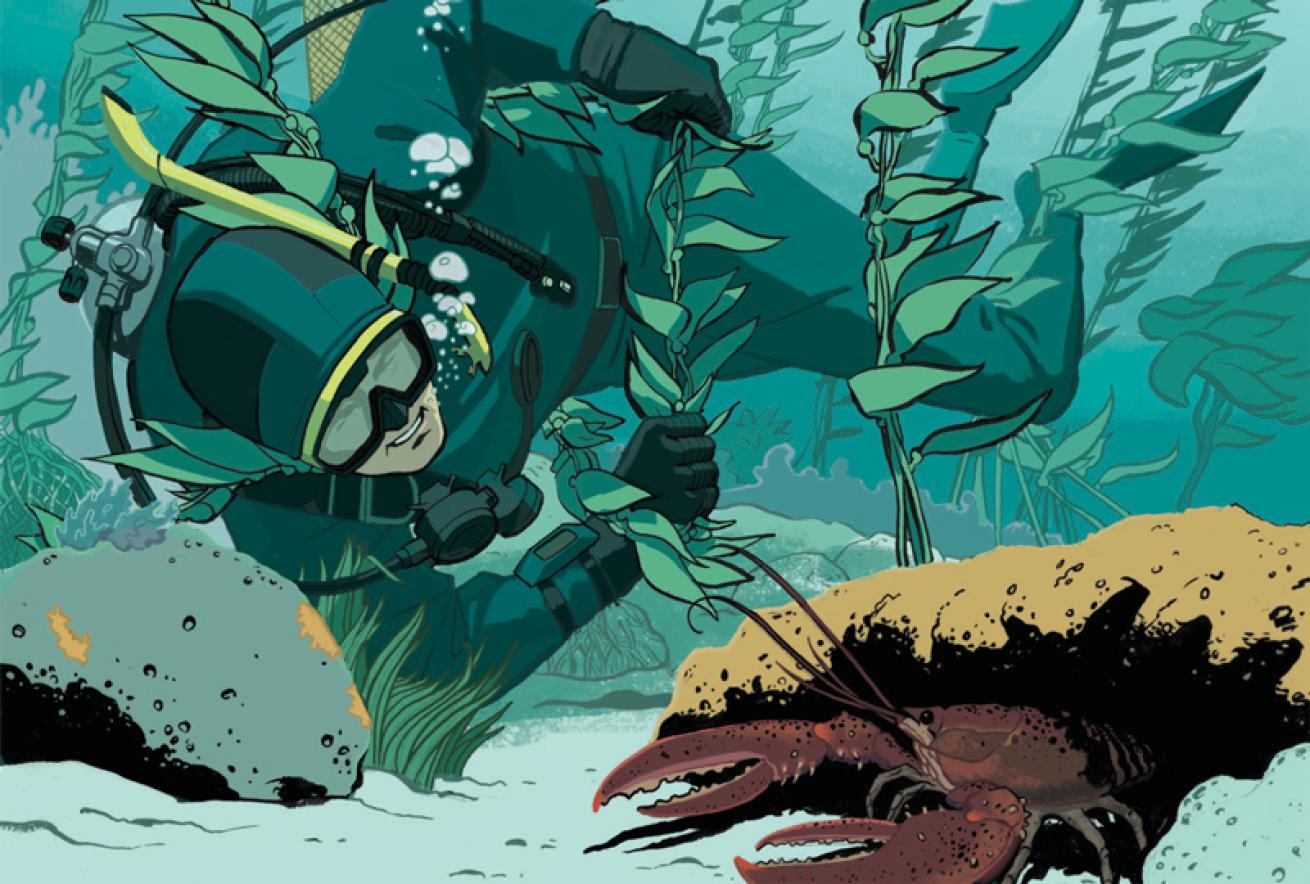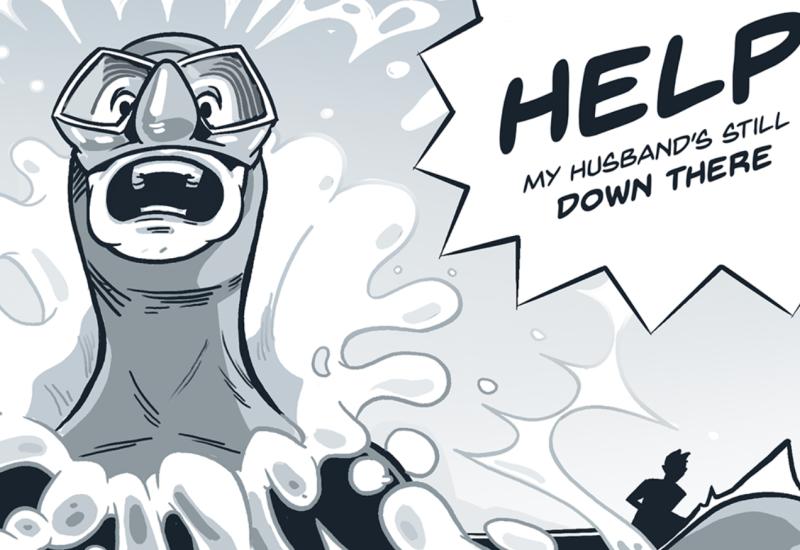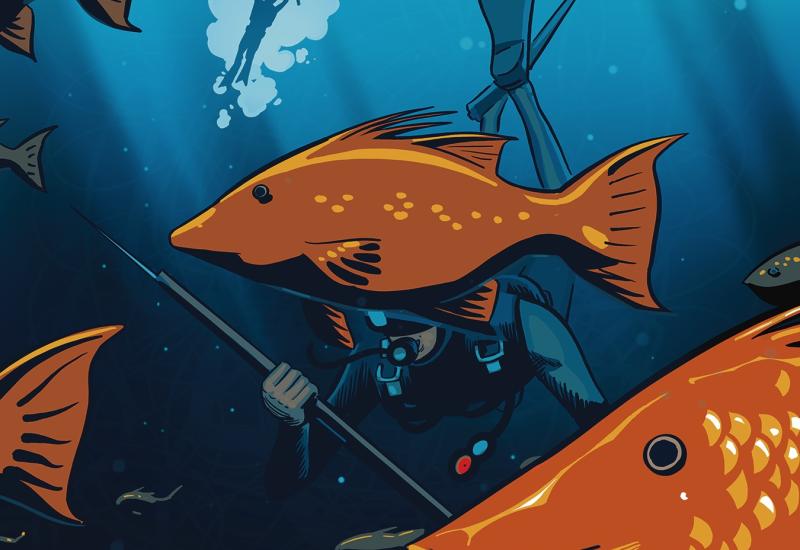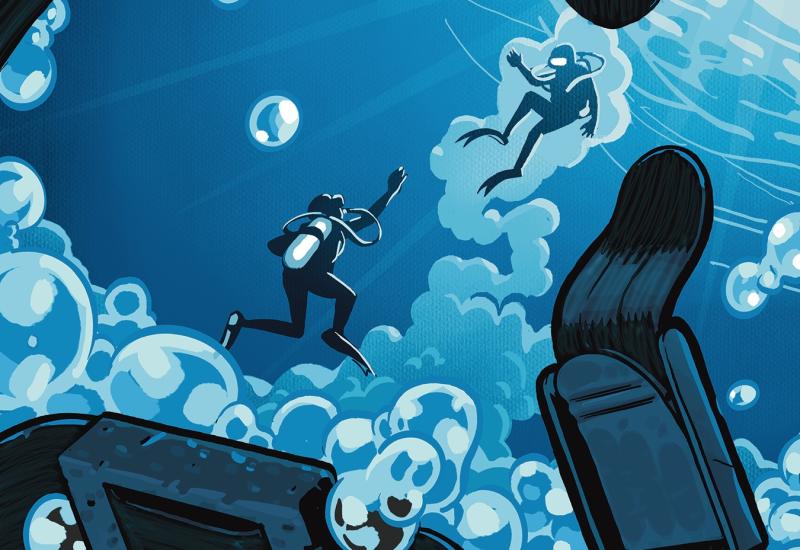Lessons for Life: Panic in Kelp

Kelp Entanglement
Panicking while tangled in kelp can lead to a deadly diver experience.
Jori Bolton
Everyone in Jake’s neighborhood liked it when Jake went diving for lobster. He always caught his limit and fired up the grill, inviting his neighbors over for a cookout. Jake was thinking of calling his friends and trying out a brand new grill as soon as he got home when he saw a lobster hiding to his right. He pushed a stand of thick kelp out of his way and then realized he couldn’t move. He was stuck and wasn’t sure what to do next.
THE DIVER
Jake learned to dive when he was 14 and had logged hundreds of dives in the 10 years since. He was fit and healthy, a self-described water dog. He love surfing and boating, but he especially loved diving. For Jake, scuba was a means to an end, though: He really loved to catch lobster. He had a special spot where he always went. The kelp in the cold California water was so thick there that he preferred to dive alone; there just wasn’t enough room for two divers to move in and around the kelp. He didn’t like worrying about anyone else in the water, either.
THE DIVE
Jake waded in through mild surf and swam out to his hunting area on the surface. Conditions were good and the kelp was thick, a good sign for lobster. Thick kelp meant the lobster had plenty of places to hide, but they were easier to see than back in rocks. Cold water and healthy kelp meant the lobster would be big, too.
The dive site was relatively shallow, only about 30 feet deep. Jake could see everywhere as he descended, enjoying the way the sunlight filtered from above. Since he was still close to shore, Jake could feel the waves pass over head. He rocked back and forth as each wave rolled past him, causing the kelp to sway with him.
THE ACCIDENT
Jake saw a large lobster sitting out in the open and lunged for it. As he moved forward, he felt something pulling him backward. He missed the lobster and watched it scurry away. Jake twisted around to see what was holding him back. Unable to see anything, he turned the other way. With each twist and turn, Jake wrapped more kelp around his body and his equipment. His fins, his regulator hoses and the game bag he used to hold the lobsters he collected quickly became more entangled.
Jake began to get scared, uncomfortable with the feeling of being trapped. There was no dive buddy to help him out. He was on his own. No one would even start to look for him until it was too late. His mind began to race. Using every ounce of energy he had left, he swam for the surface. Jake’s mind was on one thing: He needed to get to the surface and to air. He was in full panic mode.
Another diver saw Jake break the surface about 50 feet from the beach. Jake signaled for help and called out. Then he slipped back below the water. The weight of the kelp tangled in his gear pulled Jake back under. The diver on the beach called for help, and rescuers quickly found Jake unconscious on the bottom. There was still air in his tank, but Jake’s regulator was out of his mouth. Resuscitation efforts were unsuccessful, and his death was declared a drowning.
ANALYSIS
Dive accidents are rare, fatal dive accidents even more so. They are extremely frustrating when they could have been easily avoided. Jake was an experienced diver and had made this same basic dive many times. He got into trouble, though, when he forgot all of his training and experience after he became entangled in kelp.
Kelp is a beautiful environment to dive in, filled with amazing light and animal life throughout the water column. Giant kelp (Macrocystis pyrifera) typically anchors to rocks on the bottom and grows quickly, up to a foot a day in some cases. Kelp is also very strong. It is nearly almost impossible to break. It can be cut easily, however.
The moment Jake realized he was tangled in the kelp he should have stopped to assess the situation. In any situation where you feel yourself out of control or overwhelmed (in life and especially in diving), it is always best to stop, take a breath, think and then act. We don’t know if Jake was carrying a cutting tool, but it is highly likely. Most divers who routinely dive around kelp carry a dive tool or knife. If he had begun to cut himself loose from the kelp instead of struggling, he could have been free within moments. By continuing to struggle and pull against the kelp, he only made the situation worse, compounding the panic and limiting his possible actions to one — fleeing for the surface.
One of the best ways to avoid panic is to practice emergency skills. That way, when something happens, you don’t have to think through what you need to do. When you regularly practice emergency skills, they become second nature. While I doubt anyone would recommend getting tangled in kelp to practice freeing yourself, it would be a relatively easy thing to imagine getting tangled, recovering your dive tool and assessing the situation to cut yourself free. This is an important skill to practice for any diver who dives around shipwrecks or fishing areas that might be covered in fishing lines or nets, not just kelp.
LESSONS FOR LIFE
Stop, think, breathe and then act. The first step to avoiding any panic situation is to cut it off before it begins. Once panic sets in, there isn’t much you can do.
Carry the proper equipment. If the diver had a tool in reach he could have easily cut himself free.
Let go of your game bag. A game bag in kelp is something else to get tangled. If the diver had released the game bag, it is possible he would have been able to free himself. There is nothing worth catching that is worth dying for.
Practice emergency drills. Don’t wait until you need it to realize your dive knife is in an impossible position to reach it when you get entangled.
Dive with a buddy. Find a buddy with the same goals you have. In spite of the thick kelp, a buddy could easily have cut the diver loose and they both could have made a normal ascent.
Eric Douglas co-authored the book Scuba Diving Safety_ and has written a series of dive adventure novels and short stories as well. Check out his website at_ www.booksbyeric.com

Jori BoltonPanicking while tangled in kelp can lead to a deadly diver experience.
Everyone in Jake’s neighborhood liked it when Jake went diving for lobster. He always caught his limit and fired up the grill, inviting his neighbors over for a cookout. Jake was thinking of calling his friends and trying out a brand new grill as soon as he got home when he saw a lobster hiding to his right. He pushed a stand of thick kelp out of his way and then realized he couldn’t move. He was stuck and wasn’t sure what to do next.
THE DIVER
Jake learned to dive when he was 14 and had logged hundreds of dives in the 10 years since. He was fit and healthy, a self-described water dog. He love surfing and boating, but he especially loved diving. For Jake, scuba was a means to an end, though: He really loved to catch lobster. He had a special spot where he always went. The kelp in the cold California water was so thick there that he preferred to dive alone; there just wasn’t enough room for two divers to move in and around the kelp. He didn’t like worrying about anyone else in the water, either.
THE DIVE
Jake waded in through mild surf and swam out to his hunting area on the surface. Conditions were good and the kelp was thick, a good sign for lobster. Thick kelp meant the lobster had plenty of places to hide, but they were easier to see than back in rocks. Cold water and healthy kelp meant the lobster would be big, too.
The dive site was relatively shallow, only about 30 feet deep. Jake could see everywhere as he descended, enjoying the way the sunlight filtered from above. Since he was still close to shore, Jake could feel the waves pass over head. He rocked back and forth as each wave rolled past him, causing the kelp to sway with him.
THE ACCIDENT
Jake saw a large lobster sitting out in the open and lunged for it. As he moved forward, he felt something pulling him backward. He missed the lobster and watched it scurry away. Jake twisted around to see what was holding him back. Unable to see anything, he turned the other way. With each twist and turn, Jake wrapped more kelp around his body and his equipment. His fins, his regulator hoses and the game bag he used to hold the lobsters he collected quickly became more entangled.
Jake began to get scared, uncomfortable with the feeling of being trapped. There was no dive buddy to help him out. He was on his own. No one would even start to look for him until it was too late. His mind began to race. Using every ounce of energy he had left, he swam for the surface. Jake’s mind was on one thing: He needed to get to the surface and to air. He was in full panic mode.
Another diver saw Jake break the surface about 50 feet from the beach. Jake signaled for help and called out. Then he slipped back below the water. The weight of the kelp tangled in his gear pulled Jake back under. The diver on the beach called for help, and rescuers quickly found Jake unconscious on the bottom. There was still air in his tank, but Jake’s regulator was out of his mouth. Resuscitation efforts were unsuccessful, and his death was declared a drowning.
ANALYSIS
Dive accidents are rare, fatal dive accidents even more so. They are extremely frustrating when they could have been easily avoided. Jake was an experienced diver and had made this same basic dive many times. He got into trouble, though, when he forgot all of his training and experience after he became entangled in kelp.
Kelp is a beautiful environment to dive in, filled with amazing light and animal life throughout the water column. Giant kelp (Macrocystis pyrifera) typically anchors to rocks on the bottom and grows quickly, up to a foot a day in some cases. Kelp is also very strong. It is nearly almost impossible to break. It can be cut easily, however.
The moment Jake realized he was tangled in the kelp he should have stopped to assess the situation. In any situation where you feel yourself out of control or overwhelmed (in life and especially in diving), it is always best to stop, take a breath, think and then act. We don’t know if Jake was carrying a cutting tool, but it is highly likely. Most divers who routinely dive around kelp carry a dive tool or knife. If he had begun to cut himself loose from the kelp instead of struggling, he could have been free within moments. By continuing to struggle and pull against the kelp, he only made the situation worse, compounding the panic and limiting his possible actions to one — fleeing for the surface.
One of the best ways to avoid panic is to practice emergency skills. That way, when something happens, you don’t have to think through what you need to do. When you regularly practice emergency skills, they become second nature. While I doubt anyone would recommend getting tangled in kelp to practice freeing yourself, it would be a relatively easy thing to imagine getting tangled, recovering your dive tool and assessing the situation to cut yourself free. This is an important skill to practice for any diver who dives around shipwrecks or fishing areas that might be covered in fishing lines or nets, not just kelp.
LESSONS FOR LIFE
Stop, think, breathe and then act. The first step to avoiding any panic situation is to cut it off before it begins. Once panic sets in, there isn’t much you can do.
Carry the proper equipment. If the diver had a tool in reach he could have easily cut himself free.
Let go of your game bag. A game bag in kelp is something else to get tangled. If the diver had released the game bag, it is possible he would have been able to free himself. There is nothing worth catching that is worth dying for.
Practice emergency drills. Don’t wait until you need it to realize your dive knife is in an impossible position to reach it when you get entangled.
Dive with a buddy. Find a buddy with the same goals you have. In spite of the thick kelp, a buddy could easily have cut the diver loose and they both could have made a normal ascent.
Eric Douglas co-authored the book Scuba Diving Safety and has written a series of dive adventure novels and short stories as well. Check out his website at www.booksbyeric.com
About Lessons for Life
We're often asked if the Lessons for Life columns are based on real-life events. The answer is yes, they are. The names and locations have been removed or altered to protect identities, but these stories are meant to teach you who to handle a scuba diving emergency by learning from the mistakes other divers have made. Author Eric Douglas takes creative license on occasion for the story, but the events and, often, the communication between divers before the accident are entirely based on incident reports.










